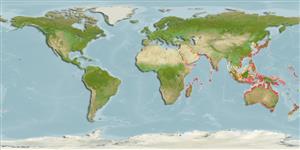Environment: milieu / climate zone / depth range / distribution range
Ecología
marino asociado a arrecife. Tropical
Indo-West Pacific: Arabian Sea to southern Japan.
Length at first maturity / Tamaño / Peso / Age
Maturity: Lm ?, range 34 - ? cm
Max length : 60.0 cm TL macho / no sexado; (Ref. 9710)
Inhabits coastal reefs, near rocky and coral areas (Ref. 9710). In Hong Kong live fish markets (Ref. 27253).
Life cycle and mating behavior
Madurez | Reproducción | Puesta | Huevos | Fecundidad | Larva
Oviparous, distinct pairing during breeding (Ref. 205).
Masuda, H. and G.R. Allen, 1993. Meeresfische der Welt - Groß-Indopazifische Region. Tetra Verlag, Herrenteich, Melle. 528 p. (Ref. 9137)
IUCN Red List Status (Ref. 130435)
Threat to humans
Harmless
Human uses
Pesquerías: comercial; Acuicultura: comercial
Más información
ReferenciasAcuiculturaPerfil de acuiculturaRazasGenéticaElectrophoresesheritabilidadEnfermedadesProcesamientoNutrientsMass conversion
ColaboradoresImágenesStamps, Coins Misc.SonidosCiguateraVelocidadTipo de nataciónSuperficie branquialOtolitosCerebrosVisión
Herramientas
Special reports
Download XML
Fuentes de Internet
Estimates based on models
Preferred temperature (Ref.
123201): 16 - 29.2, mean 27.8 °C (based on 3072 cells).
Phylogenetic diversity index (Ref.
82804): PD
50 = 0.5000 [Uniqueness, from 0.5 = low to 2.0 = high].
Bayesian length-weight: a=0.01950 (0.00846 - 0.04494), b=2.95 (2.75 - 3.15), in cm total length, based on LWR estimates for this (Sub)family-body shape (Ref.
93245).
Nivel trófico (Ref.
69278): 3.5 ±0.49 se; based on food items.
Resiliencia (Ref.
120179): Medio, población duplicada en un tiempo mínimo de 1.4-4.4 años (Preliminary K or Fecundity.).
Fishing Vulnerability (Ref.
59153): Moderate vulnerability (44 of 100).
Nutrients (Ref.
124155): Calcium = 26 [12, 52] mg/100g; Iron = 0.488 [0.255, 0.881] mg/100g; Protein = 18.9 [16.9, 20.8] %; Omega3 = 0.096 [0.048, 0.170] g/100g; Selenium = 38.5 [21.5, 69.2] μg/100g; VitaminA = 45.8 [13.7, 147.2] μg/100g; Zinc = 0.905 [0.590, 1.358] mg/100g (wet weight);
